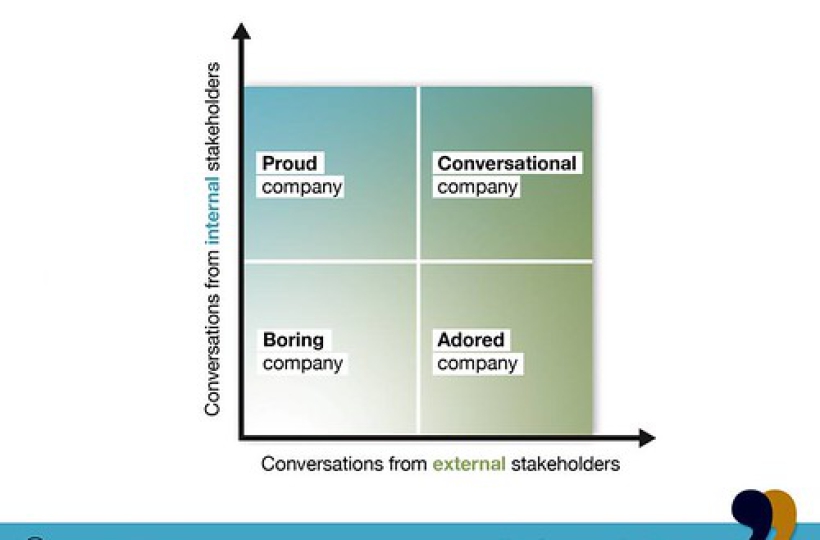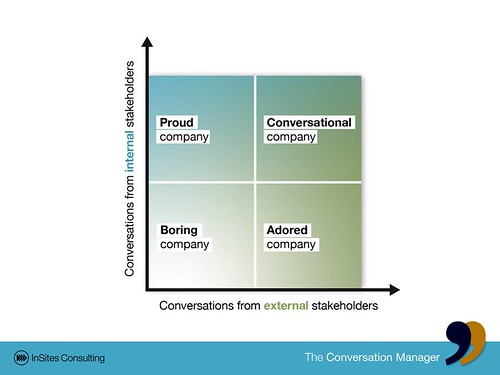The Conversation Company: The power of people as a positive booster on your path to growth

A strong client oriented company culture is the heart of the Conversation Company. The culture is the conversation guide for employees and clients. In today’s post, I focus on the power of the people and how companies can leverage this unique asset.
INTERNAL AND EXTERNAL COMMUNICATION FORM A PERFECT DUO
Under the old management model, all power was vested in the company. This meant that all communication was guided by the wishes of the commercial department. This communication was also one directional: from inside to outside. In my book The Conversation Manager I described how this traditional style of communication is a finite process. To be effective, modern advertising must be the start of a good conversation, and the advertisers need to take part in that conversation. Dialogue thinking must triumph over the broadcast model.
The Conversation Company applies the concept of the total company. In other words, the Conversation Company knows how to deal sensitively with the inverted hierarchy and is able to deal respectfully with „people power‟ both inside and outside the company. Their management model is designed to facilitate the conversations of both employees and customers, with the aim of generating as many positive and impactful conversations about the company as possible. People – both inside and outside the company – are the most important source of conversations. When faced with this situation, a classic company behaves reactively and with suspicion; in contrast, a Conversation Company is proactive and positive.
Internal and external conversations are complementary. Your employees make your culture tangible. Everything that they say and do reflects what your company stands for. Customers converse about their experience of your company and your products. Both types of conversation influence public opinion and, consequently, your company results. For this reason, companies are becoming more and more aware of the power of the conversing customer. However, the role played by employees is still seriously undervalued.
Four types of companies
By combining these two sources of conversations (internal and external), we can arrive at four different types of company:
- Boring companies: These are the companies that nobody talks about; largely because there is little or nothing to say. If you position your company in this quadrant, you are in serious trouble! In reality, this type of company does not exist in normal circumstances. It is all a question of what you make of it yourself. Every company has a story. The trick is to (want to) do something with it. Someone in the public service sector recently said to me that his sector belongs in this quadrant „almost by definition‟. This is not true. I my opinion, there are no boring companies. Every company has a story to tell.
- Proud companies: In these companies, the employees form the most important source of conversations. Companies in a niche sector are often to be found in this quadrant. Advertising agencies are a good example. The staff are proud of their work. They make attractive-looking case videos of what they do. They then share them on the internet (and elsewhere) as a kind of reference. The managers/owners of advertising agencies are often influential figures who lead the conversations about their companies.
- Worshipped companies: The customers love these companies. The companies themselves don‟t say very much; they don‟t need to – the customers provide all the communication that is necessary. The most famous example in this quadrant is Apple. Apart from their CEO, very few Apple employees are visible for the outside world. It sometimes has the appearance of a closed company, but it has one of the highest conversation totals in the entire business world. The fans are so convinced by the products, that they promote the company non-stop.
- Conversation companies: These companies display the ideal combination between internal and external conversations. Companies such as Zappos and Southwest Airlines belong in this quadrant.
Combination of the two sources offers great advantages
Scoring well on both sources of conversations offers a number of important advantages. Customers mainly talk about their experiences with your products and services. Your staff talk mainly about the culture and important events in your company. This combination ensures a good content mix. This increases the likelihood that potential new customers will easily find information about you on Google, since the search engine has recently adjusted its algorithm in favour of social conversations. This means, for example, the Twitter messages now come higher in the order of search results. Moreover, information which is accessed in this way has a very high credibility rating. In other words, it can be a huge help in finding you new customers.
During conversations, your staff and your customers will often come into contact with each other, which narrows the gap between the internal and the external world. This makes your company much more „human‟ for your customers. Your anonymous organisation suddenly acquires a face (or a voice, at least). This makes the company easier to approach. It also strengthens the emotional bond between your employees and your customers. In this way, the outside world will gradually gain more trust and confidence in you. This gives your own conversations even greater impact.
And the most important advantage? A McKinsey study has shown conclusively that companies whose internal and external worlds are closely linked grow fastest of all.
Help your employees
A lot of companies are trying to catch the consumer conversations, but only a few companies are thinking about the role of their biggest ambassadors: their own staff? A lot of companies are still afraid to let their employees talk about their job on the internet. I feel this is a missed opportunity.
Of course, it is important that your conversation guide (culture) is clear to them and that you facilitate their conversations. The Conversation Company facilitates the conversations of its employees at three levels:
- Trust: The employees are sometimes uncertain about what their employers will allow them to do. In these circumstances, they will usually prefer to do nothing, rather than make a mistake. This is a waste of their good intentions and their conversation potential. By providing strong values, clear guidelines and, above all, relevant training, the Conversation Company offers sufficient comfort to its staff, so that they can approach their online conversations with confidence.
- Content: How to talk, what to talk about, how to respond to criticism, etc.: the Conversation Company instructs its employees in all these matters, and many more besides. In this way, it is possible to create a conversation comfort zone, in which the employees feel relaxed and confident to talk with others about their work.
Tools: The Conversation Company provides the right software and hardware, so that its employees can participate easily and fluently in conversations. For example, the Dutch Rabobank is prepared to provide staff with whatever hardware tools are necessary to do the job. 100 If someone can show that they need an iPad to communicate effectively with their customers, Rabobank will issue them with an iPad.
This Monday, I’ll discuss the role of social media in the philosophy of the Conversation Company. Once you have a great customer centric culture and people to make it tangible, social media are the perfect partner to enlarge the great stories of your company and to structurally collaborate with your external stakeholders.
In the meantime, I am wondering on how you look at facilitating employees as brand ambassadors. What can companies do to use this fantastic asset in an open, authentic and positive way?
